Princess Anna, just over a year old, died on a cold January day, struck down by a sudden illness in the darkness of winter. The year of the tragic event was 1319. And yet, despite the many centuries gone by, the unfortunate child is still with us.
To see her, I enter a vestibule cloaked in darkness. With my first gingerly steps, lights come on, triggered by a movement detector, revealing a small hall with an arched vault held up by a central pillar. Then another light switches on, in a vitrine built into an old ornate cabinet. It discloses a gruesome sight: the mottled, mummified body of a small child. Its legs are crossed like Christ on the cross, a simple white cloth is draped over the genitals. The fingernails are clearly visible. The head looks too big for the shrunken body, the mouth is slightly agape. Meet Princess Anna, daughter of Emperor Louis IV. Her last, and rather public, resting place is the vestibule of the church at the Kastl Abbey. The majestic monastery sits on top of a steep hill, high above the picturesque village of Kastl and the small Lauterach River.
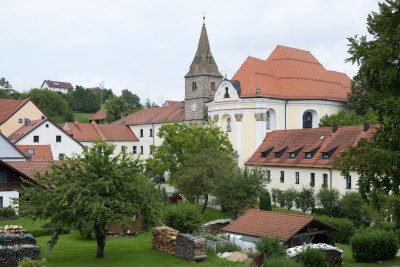
This encounter struck me as an appropriate introduction into a weird and wonderful world of monasteries and churches in a rarely visited part of Germany. Kastl lies in Lower Bavaria, hidden in wooded hills. Lower Bavaria is one of the seven administrative regions of the German state of Bavaria. Its geographical position is in the very east of the state, bordering the Czech Republic. The area trails behind the rest of Bavaria economically and is considered to be the most conservative part not only of Bavaria but of the whole of Germany. Changes don’t come easily in this part of the world. Tradition and religion define Lower Bavaria and it doesn’t come as a surprise that it has a very rich sacred heritage.
It is July, the height of summer, when I embark on a journey into a spiritual and sometimes not-so-spiritual world. Dotted throughout Lower Bavaria’s peaceful rural scenery, now lush and heavy with yield, are amazing examples of monasteries and churches, which are cultural and architectural monuments full of artistic masterpieces as much as they are places of worship. It is important to realise that many of the monasteries are no longer in the hands of nuns and monks. During the secularisation of 1802/1803, monastic lands and buildings were seized by the state or sold. Bavaria became a secular state and many monasteries, although still referred to as such, nowadays house schools, organisations, sometimes businesses or even luxurious holiday accommodation. Its churches now serve as parish churches. But don’t be fooled: despite the secularisation, the Catholic Church is still powerful and plays an essential part in Bavaria’s society.
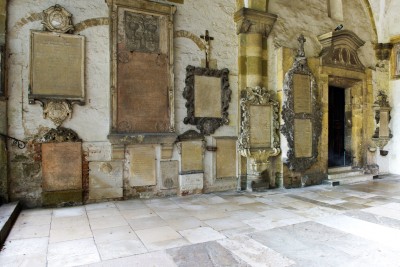
Showpieces of this power are the often magnificent churches. Some are the destinations of devout pilgrims, some are on the tourist trail and attract crowds as big as Bavaria’s famous castles, while others are hidden jewels rarely visited. Together with the monasteries, they offer the best way into the very soul of this rural province. I soon discover that there is an aspect to Bavarian monasteries that enhances the experience beyond the spiritual, beyond just savouring the architectural and artistic wonders of its churches.
I’m near the top of a landmark hill crowned by a prominent church, the 432-metre-high Bogenberg. From here, the view extends over the lowlands, a mosaic of golden and green fields. Infinity is obscured by summer haze at the end of another glorious day. Somewhere out there, hidden in the pastel opacity, is the historic town of Straubing. Deep below flows the Danube, framed by a thin strip of trees on either side. Barges and river boats slowly cruise by and it feels as if time has slowed down. I have a front-row seat for this peaceful panorama — under the shade of a chestnut tree in a beer garden that belongs to a gasthaus aptly called Zur Schönen Aussicht (beautiful view). In front of me is a half-litre glass of golden cold beer and the menu promises tasty Bavarian specialties. A couple of minutes walk from this peaceful culinary and entirely secular enclave is the church. It sits in a commanding position on the highest point. Famous as the Sanctuary of the Assumption, it is considered the oldest pilgrimage church in Bavaria and the Bogenberg itself is often called the Holy Mountain of Lower Bavaria.
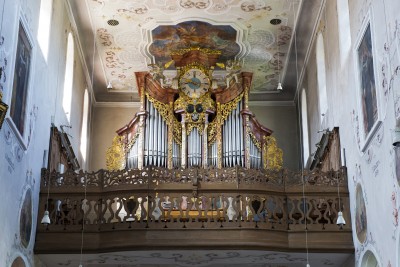
After devouring a spicy goulash soup in the beer garden I arrive just in time for the end of a mass celebrating the beginning of the summer break for Bavarian schools. The church empties and parents with their children in tow flock down to the beer garden. I have the church to myself. Then suddenly the organ starts, launching into a soaring piece. I can feel that the organist thinks he is alone and, without pressure, lets go. It is powerful, mesmerising. A young local couple on their evening walk saunter in, stay a while, listening, then head out again, most likely joining the others in the beer garden. Their brief visit to the church feels totally natural because the church is part of everyday life here. Churches in this part of the world are much more than a place to worship on Sundays.
It is not a coincidence that an inn with a beer garden is close to the church. There is a symbiosis between those secular and divine institutions. Many monasteries have a so-called klosterwirtschaft, inns or taverns within their walls, and some even brew their own beer. Lifestyle and religion are still deeply interwoven here in Lower Bavaria. Those who come and worship don’t have to go hungry and thirsty. Maybe the earthly pleasures offered by the inns and beer gardens give an extra incentive for reluctant worshippers?
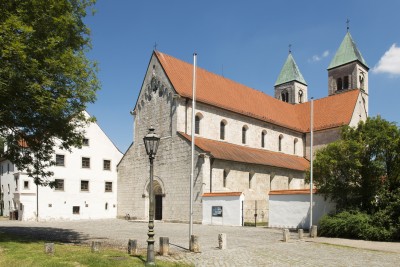
In the hills opposite Bogenberg, just a few kilometres as the crow flies, is the village of Windberg with the monastery of the same name. I find a cosy, well appointed room in one of the guesthouses there for €25 a night and an extra €2.50 for a complete breakfast with sliced meat, a soft-boiled egg, cheese, a selection of bread rolls, jam and butter and a pot of coffee. Being a little off the beaten tourist track has its advantages. Part of the village is a large monastic complex. Restored in the years between 1995 and 2005, most buildings surrounding the church are now in private hands. At the centre of the complex is the church, a three-aisled basilica with transept and its monumental main portal. The origins of the church go back to the 12th century. The impressive baroque high altar, however, was built between 1735 to 1740.
After a stroll through the complex, I follow one of the suggestions of my landlord and walk along a small farm road up the hill to the pilgrimage church of the St Cross at Kreuzberg. Tremendous views open up along the way. Below me is the village of Windberg, dominated by the church steeple. Across a broad valley rises Bogenberg. I’m surrounded by fields and paddocks and further up the forest starts. There is an understated beauty here, entwined with history, a quiet cultural landscape that invites contemplation, meditation.
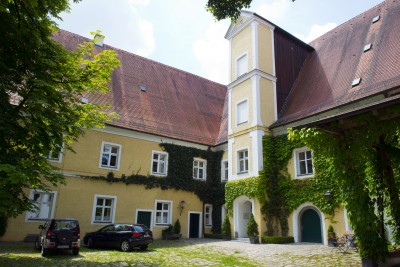
The contrast to this idyllic hidden corner around Windberg couldn’t be bigger when I arrive at the famous Benedictine abbey of Weltenburg. The car park, liable to charges, is full. In the bus section rows of transporters line up. The short walk from the car park to the monastery is crowded with tourists. There is, however, another quieter approach to the abbey. From the village of Weltenburg, I follow a small farm road up to the Frauenberg, a hill high above the Danube. Framed by forest and freshly cut meadows, the walk passes the stone foundation of a Roman fort before descending towards the river. The afternoon sun is still powerful and there is a heady scent of freshly cut grass and pine in the air. You can count the number of people here on one hand. The abbey is still hidden but a chapel on the fringe of the forest announces it. Then the red roofs of the buildings become visible through the trees and the cacophony of many voices drifts up. After a steep descent over stone steps, I enter the grounds and dive into a maelstrom of people. The beer garden is packed, tour guides herd their customers towards the main church. The crowd is international as the abbey features prominently as an outing for river cruisers on the Danube. ‘‘No-photography’’ signs, largely ignored by owners of smartphones, are further examples of the restrictions that come with sometimes overwhelming popularity. There are good reasons for its popularity, however. The Benedictine abbey of Weltenburg is the oldest monastery in Bavaria and was founded around 600 AD. The abbey is built on the inner side of a river bend, backed by steep forested hills. Just a few minutes walk downriver is the entrance to the scenic Danube gorge with its dramatic limestone cliffs that soar 80 metres above the river. The picturesque location, although within walking distance to the next village, has the feel of remoteness. Then there is the famous baroque church, the main destination for many visitors, pilgrims, tourists, cultural connoisseurs alike. Built by the architect brothers Cosmas Damian Asam and Aegid Quirin Asam, the church is awe-inspiring even if you are an atheist. But the real highlight, if you take the bustling beer garden within the abbey’s walls to substantiate the assumption, is beer. The monks here have been at it for a very long time as the Klosterbrauerei Weltenburger is considered the oldest brewery in the world, going back to the year 1050. The clear, cold water the monks use for their famous brew comes from an 80-metre-deep well under the brewery.
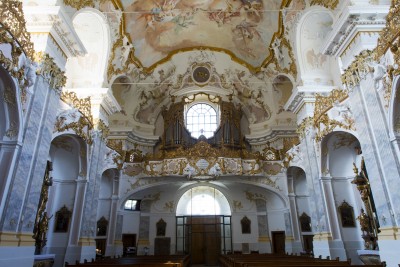
The restless, noisy masses, however, give this extraordinary place a slight Disney feel and trigger my flight instincts. I ask to get ferried across the river in one of the many zillen, small traditional boats used on the Danube. On the other side walking trails head into a different world, that of cool beech forests and lofty lookouts from limestone clifftops. The drone of noisy sightseers is replaced by birdsong.
Weltenburg is not the only monastery where I encounter big crowds. The day of my visit, a parking spot in the vicinity of Aldersbach Abbey, a former Cistercian monastery, is hard to come by. Rangers are on the prowl in the streets, ready to slap a ticket under your windscreen wipers if you dare to disobey the signs. The reason for this rush, however, is not one of tourism fame. As far as famous monasteries in Lower Bavaria go, Aldersbach is one of the more obscure ones. Founded in 1127, the buildings were sold during the secularisation in 1803 and the abbey church was converted into a parish church. The reason for the crowds is a country fair displaying local products and businesses. That the fair is located within the monastery grounds makes sense. One of the most prominent businesses in the area is situated right here: the Brauerei Aldersbach, a brewery going back to the year 1268. It would be a real shame, however — seduced by the pleasures of Bavarian lifestyle — to neglect a visit to the church. Look out for the extraordinary woodcarving of the Jonasfisch there, depicting a whale about to spit out the prophet Jonah.
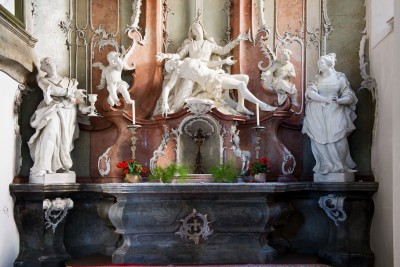
With no crowds, no brewery (the one that existed there closed in 1991) and no tavern, the Biburg Abbey is as obscure as it gets. And yet the drive along confusing and winding country roads, through ripe golden cereal fields, forest enclaves and rolling hills, is worth it. It is one of the few destinations on this trip that are purely reserved for the connoisseur of all things sacred. The former convent of Benedictine in the sleepy village of Biburg contains a church that has remained virtually unchanged in its structural substance and integrity since its inauguration in 1140. It is one of the most important Romanesque monuments and one of the oldest surviving churches in Bavaria. The contrast to the opulent baroque churches is stunning: the church Maria Immaculata at Biburg with its two plain steeples is almost austere, has clear lines and no frills. The impressive west portal goes back to the time of construction of the church with a consecration date of 1133. From the moment you see the portal the sense of age is overpowering. Built out of limestone and tufa and laid out in the form of a cross, the east-facing, three-nave pillar basilica, despite its simplicity, holds many fascinating details worth discovering. Medieval stone reliefs such as the one of Christ above the portal as well as symbolised depictions of some of the seven deadly sins are examples.
Biburg is an exception, however. Most other monasteries cater to both physical as well as spiritual needs. I therefore shift my focus to the more mundane but stay with the topic. Following a local recommendation, I head for the monastery in Waldersbach, a former abbey with a fascinating, essentially Romanesque church with a rococo tower. This time culinary pleasures come before cultural and spiritual ones. A visit to the church and the nearby monastery of Reichenbach can wait. The Gasthof Rückerl within the monastic buildings beckons the hungry traveller. A blackboard announces today’s specials with one dish very much to my liking: bread dumplings, a Bavarian staple, with wild mushrooms. July marks the beginning of the mushroom season in Lower Bavaria and the chance to taste fresh porcini and chanterelles is too tempting. Sitting on the terrace at the back of the building, I look down to the peaceful and rather romantic river Regen and a lush fruit and vegetable garden. It occurs to me that all the monasteries I visited during this journey were built at exceptionally beautiful locations. Some dominate the view from afar by sitting on top of prominent hills, some are built along Lower Bavaria’s pristine rivers. Other are part of the fabric of medieval towns and cities.
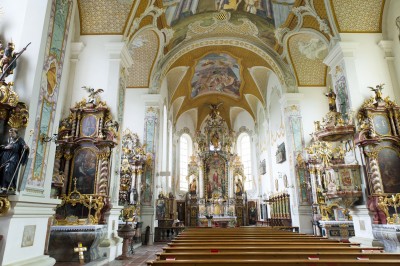
There are many more monasteries in this part of Bavaria, as well as associated breweries and inns. It is a case of pick and choose, to restrict, simply to avoid a feeling of being churched-out. If you are in this part of the world, the impressive ruin of the church at the former monastery Gnadenberg is worth a visit. And if opulent baroque churches are your thing, Rohr Abbey has to be on the itinerary. The same applies to the abbeys of Frauenzell, Metten, Niederalteich, Plankstetten and Fürstenzell. Kloster Mallersdorf might attract you because of its small brewery, run by nuns. And at Sankt Salvator, you will find some very upmarket holiday accommodation within the ancient buildings of the monastery. Let me finish this journey into the rich world of Lower Bavaria by heading for the relative big smoke — the beautiful city of Regensburg. There are many reasons to visit this urban gem. One of them is definitely St Emmeram. Now owned by Bavarian royalty, the Thurn und Taxis dynasty, the former Benedictine monastery is also known as the Thurn und Taxis schloß (castle). A visit to the stunning basilica there seems the perfect way to round off my visit of Lower Bavaria. Emerging from the dark church, I feel as if all my past and future sins — mainly gluttony, I’m afraid — are now forgiven. Then it is high time to head for the closest gasthof.









